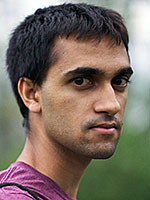Rahul Sridhar author page
1 puzzle by Rahul Sridhar
with Constructor comments
See the 1 answer word debuted by Rahul Sridhar.
| N | P | R | S | I | N | R | A | S | P | E | D | |||
| A | R | I | T | O | O | C | O | N | Q | U | E | R | ||
| V | I | N | C | E | N | T | O | C | T | U | P | L | E | |
| I | M | G | U | R | O | L | D | Z | A | P | ||||
| E | S | T | E | R | E | Y | R | E | S | T | ||||
| L | O | U | I | E | S | E | E | T | H | E | ||||
| W | I | F | E | S | E | R | I | A | L | E | U | R | ||
| E | D | I | T | O | U | T | N | U | M | B | E | R | S | |
| L | A | B | D | R | Y | E | S | T | E | R | I | E | ||
| S | H | O | D | D | Y | V | I | E | W | S | ||||
| H | O | N | E | L | E | D | A | T | O | P | ||||
| A | F | T | O | N | E | S | I | L | O | S | ||||
| P | U | C | C | I | N | I | O | T | H | E | L | L | O | |
| E | N | C | O | R | E | S | U | S | E | I | L | L | ||
| C | O | I | N | E | D | T | A | R | E | Y | E |
We've been friends through high school and college, and over the years we've bonded over math, crosswords, computer science, and puzzlehunts. We're excited to be making our New York Times debut!
When thinking of a theme, our inner math nerd shone through, and we wondered if we could use clue numbers in an unconventional way. After a few iterations, we came up with what seemed like a crazy idea involving famous mathematical sequences. While we were excited about the concept, we had no idea if there was a grid that worked, and it's practically impossible to find one by hand.
In the end, we had to write a comically complicated program that generated feasible grids, and then checked a few hundred candidates manually until we found the grid you see in today's puzzle (you can read more on this blog post). It isn't perfect—it's heavy on three-letter words and has a few cheater squares—but we were happy with the outcome. We also considered sequences like CUBE, POWEROFTWO, PERFECT, and COMPOSITE but none of them ended up in the final puzzle.
Filling out the grid was a real challenge, because we couldn't add or remove black squares without breaking our theme. That being said, we were pretty happy with the diversity and quality of our resulting fill given these constraints.
